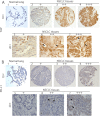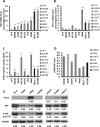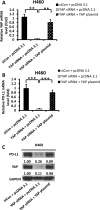YAP regulates PD-L1 expression in human NSCLC cells - PubMed (original) (raw)
. 2017 Dec 9;8(70):114576-114587.
doi: 10.18632/oncotarget.23051. eCollection 2017 Dec 29.
Ping-Chih Hsu # 1 3, Yi-Lin Yang 1, Zhidong Xu 1, Yuyuan Dai 1, Yucheng Wang 1, Geraldine Chan 1 4, Zhen Huang 1 5, Bin Hu 2, Hui Li 2, David M Jablons 1, Liang You 1
Affiliations
- PMID: 29383103
- PMCID: PMC5777715
- DOI: 10.18632/oncotarget.23051
YAP regulates PD-L1 expression in human NSCLC cells
Jinbai Miao et al. Oncotarget. 2017.
Abstract
Programmed death-ligand 1 (PD-L1) is a membrane protein on tumor cells that binds to the PD-1 receptor expressed on immune cells, leading to the immune escape of tumor cells. Yes-associated protein (YAP) is a main effector of the Hippo/YAP signaling pathway, which plays important roles in cancer development. Here we show that YAP regulates PD-L1 expression in human non-small cell lung cancer (NSCLC) cells. First, we investigated YAP and PD-L1 expression at the protein level in 142 NSCLC samples and 15 normal lung samples. In tumor tissue, immunohistochemistry showed positive staining for YAP and PD-L1, which correlated significantly (n = 142, r = 0.514, P < 0.001). Second, in cell lines that express high levels of PD-L1 (H460, SKLU-1, and H1299), the ratio of p-YAP/YAP was lower and GTIIC reporter activity of the Hippo pathway was higher than those in three cell lines expressing low levels of PD-L1 (A549, H2030, and PC9) (P < 0.05). Third, in the same three cell lines, inhibition of YAP by two small interfering RNAs (siRNAs) decreased the mRNA and protein level of PD-L1 (P < 0.05). Fourth, forced overexpression of the YAP gene rescued the PD-L1 mRNA and protein level after siRNA knockdown targeting 3'UTR of the endogenous YAP gene. Finally, chromatin immunoprecipitation (ChIP) assays using a YAP-specific monoclonal antibody resulted in the precipitation of PD-L1 enhancer region encompassing two putative TEAD binding sites. Our results indicate that YAP regulates the transcription of PD-L1 in NSCLC.
Keywords: hippo pathway; non-small cell lung cancer; programmed death-ligand 1; yes-associated protein.
Conflict of interest statement
CONFLICTS OF INTEREST The authors declare no competing financial interests.
Figures
Figure 1. Immunohistochemistry of YAP and PD-L1 in human NSCLC tissues
Representative image showing expression of YAP protein (A) and PD-L1 protein (B) in human NSCLC tissues and normal lung tissues analyzed by immunohistochemistry. (A:1) and (B:1) are normal lung tissues. (A:2–7) and (B: 2–7) are NSCLC tissues. (A:5–7) Staining of YAP was localized in nuclei (arrow) and (B:5–7) staining of PD-L1 was localized in membrane (arrow), under a 20× objective lens. – and + mean negative; ++ and +++ mean positive.
Figure 2. Expression of YAP and PD-L1 in NSCLC cell lines
(A–B) The mRNA levels of YAP and PD-L1 in NSCLC cell lines were measured using qRT-PCR, and LP-9 cell line was used as control (F = 174.10 P < 0.001; F = 635.77 P < 0.001). VS LP-9: *P < 0.05, **P ≤ 0.01, ***P ≤ 0.001. (C): GTIIC reporter activity of the Hippo pathway in NSCLC cell lines, and LP-9 cell line was used as control (F = 311.39; P < 0.001). VS LP-9: *P < 0.05, **P ≤ 0.01, ***P ≤ 0.001. (D) pYAP/YAP ratio in NSCLC cell lines based on the value of Western blot. (E) Western blot was used to detect levels of YAP, pYAP and PD-L1 in NSCLC cell lines. GAPDH was detected as a loading control. Band intensity was analyzed with ImageJ software and normalized with the intensity of GAPDH band.
Figure 3. YAP and PD-L1 expression in H460, SKLU-1 and H1299 cell lines after knockdown of YAP
(A) YAP mRNA level in H460, SKLU-1 and H1299 cells after YAP inhibition by siRNA1,2 was measured using qRT-PCR. (B) PD-L1 mRNA level in H460, SKLU-1 and H1299 cells after YAP inhibition by siRNA1,2 was measured using qRT-PCR. (C) Western Blot analysis in H460, SKLU-1 and H1299 cell lines transfected with YAP siRNA1,2 or control siRNA. GAPDH was detected as a loading control. Band intensity was analyzed with ImageJ software and normalized with the intensity of GAPDH band. YAP-knockdown reduced PD-L1 expression significantly. *P < 0.05, **P ≤ 0.01, ***P ≤ 0.001.
Figure 4. Expression of PD-L1 and YAP after YAP forced over-expression in siRNA-YAP H460 cells
(A–B) qRT-PCR analysis of mRNA levels of YAP and PD-L1 after YAP silencing by siRNA and/or forced over-expression of the YAP gene in H460 cells. (C) Western blot analysis of YAP, PD-L1 after YAP silencing by siRNA and/or forced over-expression of the YAP gene in H460 cells. GAPDH was detected as a loading control. Band intensity was analyzed with ImageJ software and normalized with the intensity of GAPDH band. *P < 0.05, **P ≤ 0.01, ***P ≤ 0.001.
Figure 5. YAP regulates PD-L1 at the transcriptional level through binding to PD-L1 enhancer
(A) Schematic of the PD-L1 promoter region. Sequence analysis revealed a putative YAP1-TEAD co-binding site between −7911 to −7941 nucleotides upstream of the transcription start site. (B) ChIP assays were performed with SKLU-1 and H1299 cells in two regions (203 bp and 210 bp), which were shown by gel bands of RT-PCR products with 36 cycles. (C) ChIP assays were performed with A549, H1975, H1299 and SKLU-1 cells in two regions (203 bp and 210 bp), which were shown by gel bands of RT-PCR products with 30 cycles.
Similar articles
- Inhibition of yes-associated protein down-regulates PD-L1 (CD274) expression in human malignant pleural mesothelioma.
Hsu PC, Miao J, Wang YC, Zhang WQ, Yang YL, Wang CW, Yang CT, Huang Z, You J, Xu Z, Jablons DM, You L. Hsu PC, et al. J Cell Mol Med. 2018 Jun;22(6):3139-3148. doi: 10.1111/jcmm.13593. Epub 2018 Mar 24. J Cell Mol Med. 2018. PMID: 29575535 Free PMC article. - The Role of Yes-Associated Protein (YAP) in Regulating Programmed Death-Ligand 1 (PD-L1) in Thoracic Cancer.
Hsu PC, Yang CT, Jablons DM, You L. Hsu PC, et al. Biomedicines. 2018 Dec 7;6(4):114. doi: 10.3390/biomedicines6040114. Biomedicines. 2018. PMID: 30544524 Free PMC article. Review. - Ezrin regulates the progression of NSCLC by YAP and PD-L1.
Bu F, Zhang Y, Zhao N, Tian X, Xu Y. Bu F, et al. Clin Transl Oncol. 2023 Jul;25(7):2239-2249. doi: 10.1007/s12094-023-03113-9. Epub 2023 Feb 16. Clin Transl Oncol. 2023. PMID: 36795259 - [Effect of soluble PD-L1 released by lung cancer cells in regulating the function of T lymphocytes].
Shi MH, Xing YF, Zhang ZL, Huang JA, Chen YJ. Shi MH, et al. Zhonghua Zhong Liu Za Zhi. 2013 Feb;35(2):85-8. doi: 10.3760/cma.j.issn.0253-3766.2013.02.002. Zhonghua Zhong Liu Za Zhi. 2013. PMID: 23714659 Chinese. - Development of PD-1/PD-L1 Pathway in Tumor Immune Microenvironment and Treatment for Non-Small Cell Lung Cancer.
He J, Hu Y, Hu M, Li B. He J, et al. Sci Rep. 2015 Aug 17;5:13110. doi: 10.1038/srep13110. Sci Rep. 2015. PMID: 26279307 Free PMC article. Review.
Cited by
- Tumour cell-intrinsic CTLA4 regulates PD-L1 expression in non-small cell lung cancer.
Zhang H, Dutta P, Liu J, Sabri N, Song Y, Li WX, Li J. Zhang H, et al. J Cell Mol Med. 2019 Jan;23(1):535-542. doi: 10.1111/jcmm.13956. Epub 2018 Oct 30. J Cell Mol Med. 2019. PMID: 30378264 Free PMC article. - Epithelioid Hemangioendothelioma as a Model of YAP/TAZ-Driven Cancer: Insights from a Rare Fusion Sarcoma.
Lamar JM, Motilal Nehru V, Weinberg G. Lamar JM, et al. Cancers (Basel). 2018 Jul 10;10(7):229. doi: 10.3390/cancers10070229. Cancers (Basel). 2018. PMID: 29996478 Free PMC article. Review. - Molecular profiles of different PD-L1 expression in patients with esophageal squamous cell carcinoma.
Zhao S, Hu X, Zhou P, Li A, Chen L, Wang D, He J, Jiang Y. Zhao S, et al. Cancer Biol Ther. 2023 Dec 31;24(1):2256927. doi: 10.1080/15384047.2023.2256927. Epub 2023 Sep 21. Cancer Biol Ther. 2023. PMID: 38032149 Free PMC article. - Verteporfin suppresses the proliferation, epithelial-mesenchymal transition and stemness of head and neck squamous carcinoma cells via inhibiting YAP1.
Liu K, Du S, Gao P, Zheng J. Liu K, et al. J Cancer. 2019 Jul 10;10(18):4196-4207. doi: 10.7150/jca.34145. eCollection 2019. J Cancer. 2019. PMID: 31413738 Free PMC article.
References
- Siegel R, Naishadham D, Jemal A. Cancer statistics, 2013. CA Cancer J Clin. 2013;63:11–30. - PubMed
- Chen W, Zheng R, Baade PD, Zhang S, Zeng H, Bray F, Jemal A, Yu XQ, He J. Cancer statistics in China, 2015. CA Cancer J Clin. 2016;66:115–132. - PubMed
- Ettinger DS, Wood DE, Aisner DL, Akerley W, Bauman J, Chirieac LR, D’Amico TA, DeCamp MM, Dilling TJ, Dobelbower M, Doebele RC, Govindan R, Gubens MA, et al. Non-Small Cell Lung Cancer, Version 5.2017, NCCN Clinical Practice Guidelines in Oncology. J Natl Compr Canc Netw. 2017;15:504–535. - PubMed
- Masters GA, Temin S, Azzoli CG, Giaccone G, Baker S, Jr, Brahmer JR, Ellis PM, Gajra A, Rackear N, Schiller JH, Smith TJ, Strawn JR, Trent D, Johnson DH, American Society of Clinical Oncology Clinical Practice Systemic therapy for stage IV non-small-cell lung cancer: american society of clinical oncology clinical practice guideline update. J Clin Oncol. 2015;33:3488–515. - PMC - PubMed
LinkOut - more resources
Full Text Sources
Other Literature Sources
Research Materials




